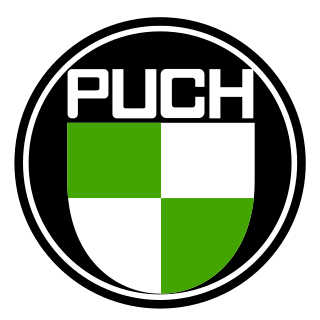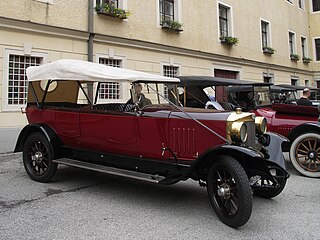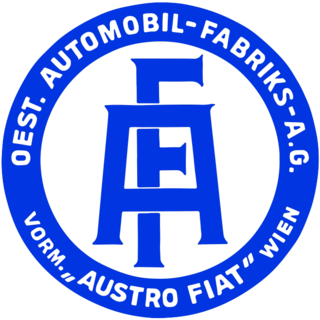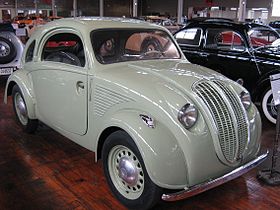
The Haflinger is a small, lightweight, four wheel drive, high mobility cab over vehicle about 3.5 m long and 1.5 m wide, powered by a 643 cc flat twin horizontally opposed, rear mounted, air-cooled engine. Weighing around 600 kg (1322.8 lb), the Haflinger can be lifted by four strong people and yet can carry a load of 500 kg (1102.3 lb). This truck falls into the category of the light utility vehicle. It was produced between 1959 and 1974 by the Austrian manufacturer Steyr-Daimler-Puch.

Ferdinand Porsche was an Austro-Bohemian automotive engineer and founder of the Porsche AG. He is best known for creating the first gasoline–electric hybrid vehicle (Lohner–Porsche), the Volkswagen Beetle, the Auto Union racing cars, the Mercedes-Benz SS/SSK, and several other important developments and Porsche automobiles.

The Fiat 500 is a city car that was manufactured and marketed by Fiat Automobiles from 1957 until 1975. It was sold as a two-door semi-convertible or saloon car and as a three-door panel van or estate car.

The Fiat 126 is a four-passenger, rear-engine, city car manufactured and marketed by Fiat over a twenty-eight year production run from 1972 until 2000, over a single generation. Introduced by Fiat in October 1972 at the Turin Auto Show, the 126 replaced the Fiat 500, using major elements from its design. A subsequent iteration, marketed as the 126 Bis, used a horizontally oriented, water-cooled engine and featured a rear hatchback.

Puch is a manufacturing company located in Graz, Austria. The company was founded in 1899 by the industrialist Johann Puch and produced automobiles, bicycles, mopeds, and motorcycles. It was a subsidiary of the large Steyr-Daimler-Puch conglomerate.

NSU Motorenwerke AG, or NSU, was a German manufacturer of automobiles, motorcycles and pedal cycles, founded in 1873. Acquired by Volkswagen Group in 1969, VW merged NSU with Auto Union, creating Audi NSU Auto Union AG, ultimately Audi. The name NSU originated as an abbreviation of "Neckarsulm", the city where NSU was located.

Hans Ledwinka was an Austrian automobile designer.

In automotive design, an RR, or rear-engine, rear-wheel-drive layout places both the engine and drive wheels at the rear of the vehicle. In contrast to the RMR layout, the center of mass of the engine is between the rear axle and the rear bumper. Although very common in transit buses and coaches due to the elimination of the drive shaft with low-floor buses, this layout has become increasingly rare in passenger cars.
Economy car is a term mostly used in the United States for cars designed for low-cost purchase and operation. Typical economy cars are small, lightweight, and inexpensive to both produce and purchase. Stringent design constraints generally force economy car manufacturers to be inventive. Many innovations in automobile design were originally developed for economy cars, such as the Ford Model T and the Austin Mini.

Austro-Daimler was an Austro-Hungarian automaker company, from 1899 until 1934. It was a subsidiary of the German Daimler-Motoren-Gesellschaft (DMG) until 1909.

Magna Steyr GmbH & Co KG is an automobile manufacturer based in Graz, Austria, where its primary manufacturing plant is also located. It is a subsidiary of Canadian-based Magna International and was previously part of the Steyr-Daimler-Puch conglomerate.
Steyr-Daimler-Puch was a large manufacturing conglomerate based in Steyr, Austria, which was broken up in stages between 1987 and 2001. The component parts and operations continued to exist under separate ownership and new names.

The Fiat 1400 and Fiat 1900 are passenger cars produced by Italian automotive manufacturer Fiat from 1950 to 1958 and from 1952 to 1959 respectively. The two models shared body and platform, but while the 1.4-litre 1400 was Fiat's intermediate offering, the upmarket 1900 had an enlarged 1.9-litre engine and more luxurious trim and equipment, to serve as flagship in the manufacturer's range.

The Volkswagen Golf Mk2 is a hatchback, the second generation of the Volkswagen Golf and the successor to the Volkswagen Golf Mk1. It was Volkswagen's highest volume seller from 1983 and ended in (German) production in late 1992, to be replaced by the Volkswagen Golf Mk3. The Mk2 was larger than the Mk1; its wheelbase grew slightly, as did exterior dimensions. Weight was up accordingly by about 120 kg (260 lb). Exterior design, developed in-house by VW design director Schäfer, kept the general lines of its Giugiaro-designed predecessor, but was slightly more rounded. All told, about 6.3 million second-generation Golfs were built.

Steyr was an Austrian automotive brand, established in 1915 as a branch of the Österreichische Waffenfabriks-Gesellschaft (ÖWG) weapon manufacturing company. Renamed Steyr-Werke AG in 1926 and merged with Austro-Daimler and Puch into Steyr-Daimler-Puch AG, it continued manufacturing Steyr automobiles until 1959.

The Puch 500 is a city car produced by the Austrian manufacturer Puch, a subsidiary of Steyr-Daimler-Puch in Graz. It was built under licence from Fiat and was based on the Fiat 500.

The Steyr 100 and 200 were a series of medium-sized cars built by the Austrian manufacturer Steyr-Daimler-Puch AG from 1934 to 1940. The four-door streamlined body designed by engineer Karl Jenschke was manufactured in Steyr, a 1933 prototype was assembled by Gläser-Karosserie GmbH in Dresden, Germany.

ÖAF is an initialism for Österreichische Automobil-Fabrik, previously known as Österreichische Austro-Fiat, an Austrian (Austro-Hungarian) car and truck manufacturer that now is completely incorporated into MAN.

The Steyr 120 Super, Steyr 125 Super and Steyr 220 were a series of medium-sized cars built by the Austrian firm Steyr-Daimler-Puch from 1935 to 1941. The moderately streamlined body was designed by technical director Karl Jenschke (1899-1969) and was manufactured by Gläser-Karosserie GmbH in Dresden. The design had a close resemblance to the smaller Steyr 100.

The Adler 2.5-litre was a sensation when first presented by Adler at the Berlin Motor Show early in 1937, although this did not convert into correspondingly sensational sales.



















